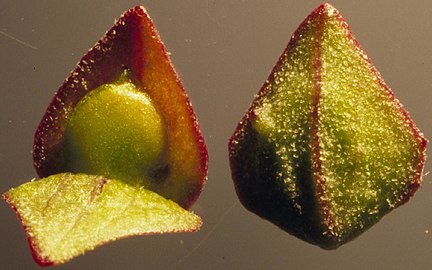| Atriplex patula | |
|---|---|

| |
|
Scientific classification
| |
| Kingdom: | Plantae |
| Clade: | Tracheophytes |
| Clade: | Angiosperms |
| Clade: | Eudicots |
| Order: | Caryophyllales |
| Family: | Amaranthaceae |
| Genus: | Atriplex |
| Species: | A. patula
|
| Binomial name | |
| Atriplex patula | |
Atriplex patula (spear saltbush; common orache; spear orach; spreading orach; /ˈɒrətʃ/ [1]) is a ruderal, circumboreal species of annual herbaceous plant in the genus Atriplex naturalized in many temperate regions.
Description
Atriplex patula grows to be between 50 and 80 centimetres (20 and 31 inches) tall. [2] The branches extend outwards from the stem with rhomboid leaves and separated clusters of flowers. [2] The species accumulates salt from the environment in its tissues. Unlike other Atriplex species, it lacks notable salt bladders to excrete salt onto the leaves. [3]
Taxonomy
The species was a member of the family Chenopodiaceae, now part of Amaranthaceae, the amaranth family. [2]
Distribution and habitat
The species has a wide range, including semi-arid deserts and coastal areas in Asia, North America, Europe, and Africa. [2] It commonly grows along roads and waste sites. [4]
Although it is commonly asserted that the species has been naturalized in North America only since the 18th century, [5] [6] seeds ascribed to this species occur on the west coast of North America in buried marsh deposits that predate European contact. [7] [8]
Uses
The young leaves and shoots are edible raw or cooked and suffice as a spinach substitute. [9]
The species has been proven to be effective in lowering salt content in soils when planted in areas with high road salt contamination. [3]
References
- ^ "orache". Oxford English Dictionary third edition. Oxford University Press. June 2004. Retrieved 7 December 2018.
- ^ a b c d Sukhorukov, Alexander; Kushunina, Maria; Verloove, Filip (2016-07-14). "Notes on Atriplex, Oxybasis and Dysphania (Chenopodiaceae) in West-Central Tropical Africa". Plant Ecology and Evolution. 149 (2): 249–256. doi: 10.5091/plecevo.2016.1181.
- ^ a b Mann, Ellen; Rutter, Allison; Zeeb, Barbara (October 2020). "Evaluating the efficacy of Atriplex spp. in the phytoextraction of road salt (NaCl) from contaminated soil". Environmental Pollution. 265 (Pt B): 114963. doi: 10.1016/j.envpol.2020.114963. PMID 32806446. S2CID 221162683.
- ^ Prokopiev, I. A.; Filippova, F. V.; Shein, A. A. (March 2012). "Effect of anthropogenic pollution with dust containing heavy metals on seed progeny of spear saltbush". Russian Journal of Plant Physiology. 59 (2): 212–216. doi: 10.1134/S1021443712020148. ISSN 1021-4437. S2CID 17780607.
- ^ Atriplex patula in Flora of North America
- ^ "USDA PLANTS Profile". Archived from the original on 2013-05-11. Retrieved 2008-05-20.
- ^ Sherrod BL, 2001. Geological Society of America Bulletin 113, 1299-1311.
- ^ Milker Y, et al., 2016. Quaternary Science Reviews 142, 143-163.
- ^ Mabey, Richard (2012). Food for Free. London: Collins. p. 104. ISBN 978-000-743847-1.

